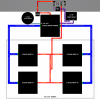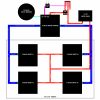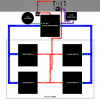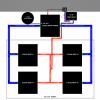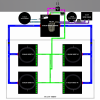I like diagrams.
Food for thought. Here, your return lines back to the epi will always be pumping chilled water to your roots. Stick your meters and make your adjustments right in the epi. Your adjustment pot is just a place for extra leaks, only in my opinion.
You can get something like a bluelab and mount it on the wall like you were saying and run the lines to epi.
LOL. If your system runs dry, your meters are the last thing you will be worried about.
Throw a spin filter on your return line where I marked it, or somewhere to protect your pump from broken root clogs.
One more thing....IIRC my 1/4hp is only rated for 600 gallons max flow but others may be different.
Thanks 5BY5LEC for the diagram...
I have multiple Bluelab Guardian Monitor Connects to show values when I'm home or away of both my RDWC systems in mirrored perpetual grows...
They are mounted in-between my (4'x4' VEG Tent) and (6'x6' Flower Room) on a suspended wall hanging from the ceiling above both RDWC Remote Epicenters where I have both Bluelab probes... with a total of 14- 5 Gallon buckets/6" net pot lids with multiple 1000GPH mag pumps from 1" to 3/4" to 1/2" waterfalls and multiple 1" bulkheads per bucket with strainers in all bulkheads to ensure no clogs in return lines... Also, had to run a separate waterfall on a valve back to Epicenter to keep water levels maintained evenly... With 1000GPH pumps pressuring up and heating the system I had to add multiple Alita-40 Linear air pumps with 1/2" air diffusers in each bucket to cool down the system as well as constantly adding 2L frozen water bottles...
All this with no chiller and water temps sticking around 72F-78F...

EEKS,,, but luckily I have never had a root pathogen,,,
I think mainly in part because I plumped in a Reverse Osmosis system...
I figure I haven't flooded yet and I want to grow longer flowering plants without worrying about flooding...
I'm always worried about clogging/flooding due to 1" return lines with the previous system and I've decided it's time to upgrade to 2" return lines and 8 Gallon buckets for my Veg Tent,,, and mirror it for my Flower Room but with 13 Gallon buckets... I want to grow TREES!!!

Was at the verge of flooding late in Flower when the roots were pushing the plant up and out of the bucket and blocking 1 of the 2 bulkheads in a bucket... That's when I decided I needed strainers for each bulkhead!!!, and learned how to root prune!!!
I would have flooded 1 time for certain if I wasn't around to catch it when a probe decided to unsecure itself from it's suction cup and block a 1" bulkhead... That's when my Epicenter got strainers too!!!
Bluelab doesn't recommend probes be directly where the mixing of nutrients/pH Up/Down/Frozen water bottles/Air bubbles are being delivered...
The probes can malfunction and will need more calibrating when around air bubbles as it is not good for the life of the probes,,, I want bubbles!!!
The Probes are fairly expensive to replace as I found out, when... You know... You invite a friend over to babysit your setup while on holiday and come home to find out they accidentally pushed down on both epi lids thinking they should be closed and pinched Probes that had to be replaced...
I think including a sample pot will make things more organized and work much easier,,, especially when cleaning and calibrating probes monthly,,,
and for when I want to quickly check my Top-Off Reservoir values,,, I can easily pull both probes out of the sample pot and drop in my Top-Off Rez,,,
or in case I forget to remember to take care of probes when I'm doing a flush or a harvest clean-out so I don't have to worry about pinching the wires,
or shortening the life of probes, etc.,,, blah, blah, blah..Period
I bought a 3/4" Wye filter (40 Screen) a few years back only to return it after talking with "Current Culture" told me it wasn't necessary and that they were steering away from them... So I listened to them and have since never had the need for a filter...
If you followed my diagram below where would you suggest the filter be placed if recommended??? Between Epi-->Pump??? At the Manifold???
As for the Chiller,,, I just received it... I've never ran one before... Very excited for my next grow!!!
Another reason for a "Manifold" is because I own 2 of the AAPW1000 which is more than recommended as you can see below,,, must be regulated...
and is the reason why I want a manifold with valves to regulate how much volume flows to: -->my sample pot -->chiller -->Epicenter -->root zone...
Active Aqua 1/4 HP Water Features:
- Large refrigeration capacity (recommended volume: 40 gal to 92 gal )
- Anti-corrosive pure titanium evaporator for both fresh and salt water
- Rate of flow: 1/4 HP (396‒925 gal/h -1500‒3500 L/h)
- Rated BTU per hour: 3,010
- PSI Rating: 10 psi maximum
- Recommended pumps: AAPW400 or AAPW550 or AAPW800
- 1/2"and 3/4" fittings included
- Unit dimensions: 18"L x 13"W x 17"H
- For cooling capability, please refer to performance chart found in the product information tab
And dont forget a drain line somewhere. You can add a "T" fitting and ball valve between the pump and chiller. When you wanna drain it, turn that valve and pump that bitch out. I saw you had already integrated it into the manifold.
I currently have my system raised off the floor by 3-3/4"... Down the road I'll add a dedicated bottom drain with Marine Thru-Hull 90 Degree fittings...
I have a shop vac for now to suck out whatever is below 2" Bulkheads...
